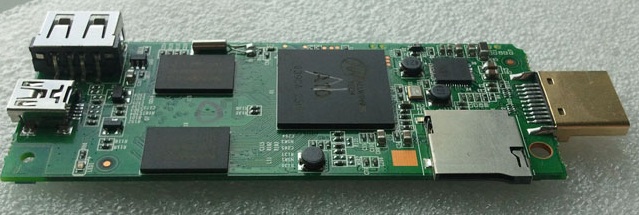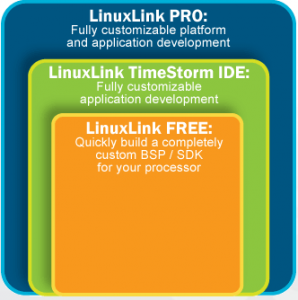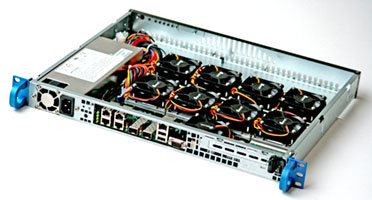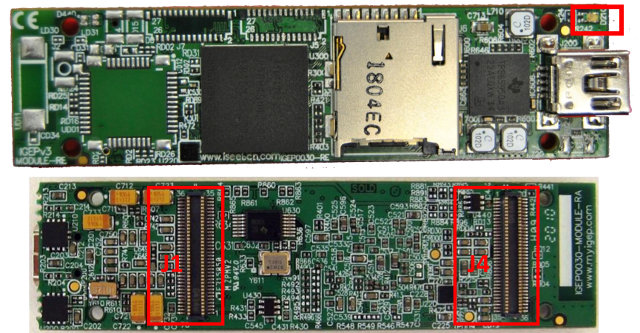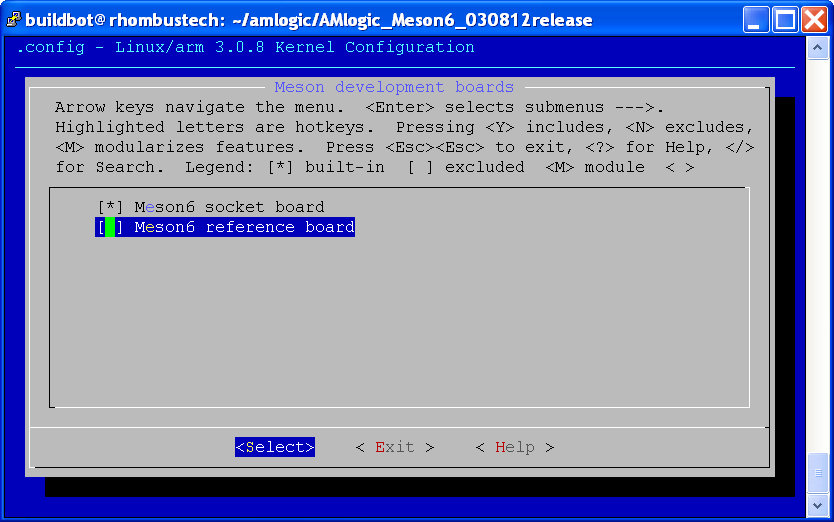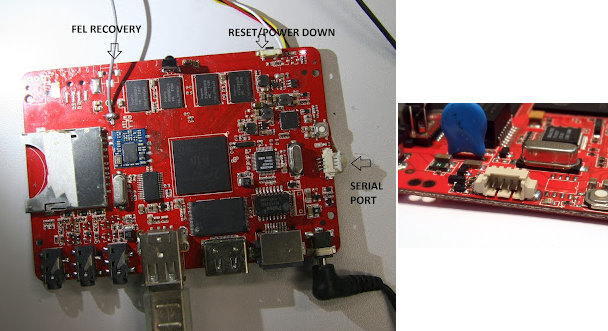Last week, I found out that AMLogic released the kernel source code for AML8726-MX, its dual core Cortex A9 processor, but this code is only for the “common” platform, and some source code specific to tablets or media players is missing (e.g. some drivers). But today, Ainol released the source code for the Ainol Novo 7 Elf II and Aurora II tablet, both of which are based on on AML8726-M6 dual core processor: Ainol Novo 7 Elf II Source Code (2 GB) – http://dl.vmall.com/c0yqzpadah Ainol Novo 7 Aurora II source code (2 GB) – http://dl.vmall.com/c0imlixp7d The files are pretty big, and the download very slow on my side (“1 day, 16 hours remaining”), so I’ll probably have to give up. I assume “fards” will import the source code into a new repo in his github account. Anyway, this potentially makes AMLogic AML8726-MX a very interesting development platform, although we’ll have to […]
QuickEmbed UPuter Pi – $69 AllWinner A10 Development Board
I’ve been informed of a new AllWinner A10 development board which is marketed as some sort of Raspberry Pi “clone”, although the hardware is different. The UPuter Pi is a small board designed by QuickEmbed Technology, a Shanghai based company, that features AllWinner A10 processor @ 1.5 GHz, 512 to 1 GB RAM, and 4 to 8 GB Flash. Here are the specs as mentioned on the company website: CPU 1.5GHz ARM Cortex-A8 multi-core Mali400 graphic engine Memory 512M/1GB DDR3 Flash 4G/8G DC 5V USB power working temperature -10 to 70C storage temperature -20 to 80C Android 4.0 WIFI/RJ45 network USB/Wireless keyboard/mouse 3G usb card TF card, U-disk, usb harddisk 720P/1080P/2160P I must have gone blind because I don’t see any RJ45 connector (for Ethernet). The board will support Android 4.0 and all the usual Linux distros supported by Allwinner A10 processor. QuickEmbed may have pushed the clone concept a […]
Timesys Unveils LinuxLink BSP/SDK for MityARM-3359 SoM (TI AM335x)
Critical Link is an electronics product development company that provides “MityDSP” and “MityARM” System on Modules and Timesys is a software company working on Embedded Linux, which provides LinuxLink, a software development framework for embedded Linux application development. Both companies have partnered to offers LinuxLink BSP/SDK for MityARM-3359 SoM based on Texas Instruments Sitara AM335x Cortex A9 processor. LinuxLink (for MityARM-335x) comes in 2 versions: A free version which includes: A wizard-based interface that simplifies the selection of a Linux kernel, software packages and tools Kernel, toolchain and debugger Access to hundreds of open-source software packages Support by Timesys for build/boot issues. A PRO version (Starts at $5495 per developer) which includes extra “features” such as: TimeStorm IDE – A desktop-based development environment Tools for advanced customization and integration unmetered support Everything is built on Timesys servers, but the web interface makes it quite customizable and offers lots of options […]
Codethink Launches The Baserock Slab ARM Server
Codethink has just announced an ARM based server called “The BaseRock Slab” powered by Marvell ARMADA XP quad core ARMv7-A processors with 2 GB RAM and 30GB (up to 120GB) mSATA SSD Storage per node, which targets applications such as cloud computing infrastructure and native ARM build and test. This 32 cores server comes in a 1U chassis (483mm x 44mm x 355m), is powered by a 260 PSU, integrates eight Cogent CSB1726-ArmadaXP SoM (Marvell Armada XP quad-core ARMv7-A CPUs, 1.33Ghz + 2 GB ECC DDR3 RAM) in to a carrier board featuring the following: 30GB (max 120GB) mSATA SSD, max 250MB/sec read/write, per SoM SATA port for additional dedicated storage, per SoM Dual 2.5Gbit/s full-duplex ethernet, trunkable into a single 5Gbit/s link Management SoM for remote power, fan and reset control Firmware upgrade via the network The server is managed by Cogent CSB1724 SoM powered by Marvell Armada 300 […]
ISEE Announces Low Cost IGEP COM ELECTRON & SPIN Computers-on-Module
ISEE, the manufacturer of the IGEPv2 board, has recently announced 2 new industrial grade computers on module based on TI Sitara AM3703 Cortex A8 Processor: IGEP COM ELECTRON – AM3703 with 256 MB RAM / 512 MB Flash – 59 Euros IGEP COM SPIN – AM3703 with 64 MB RAM / 128 MB Flash – 49 Euros Here are the specifications of IGEP COM ELECTRON module: CPU – Texas Instruments AM3703 @ 1GHz with L1 cache (112 KB (DSP) / 64 KB (ARM)) and L2 cache (96 KB (DSP), 256 KB (ARM)) System Memory – 256 MB Mobile DDR @ 200 MHz (32-bit) Storage: 512 MB NAND FLASH On board micro-SD socket Connectors: 1 x USB 2.0 OTG interface + USB mini-AB connector 1 x MICRO-SD socket 2 x EXPANSION 70-pin connector Device: 1 x USB 2.0 HOST (connector NOT included) 1 x DOUBLE LED INDICATOR Expansion connectors – 2 […]
AMLogic Releases AML8726-MX Linux 3.0.8 Source Code
While doing a Google search to locate the open Linux page of AMLogic, I noticed another link reading “Amlogic AML8726-MX Linux kernel code released“. Interesting. So AMLogic appears to have released the kernel source code for their latest dual core Cortex A9 processor at the beginning of August and the tarball is available from their open source site: kernel-common-2012-08-03-git-a63244fb9c.tar.gz. A github user (fards) also imported the code to github, but he’s not affiliated with AMLogic, so don’t expect commits from AMLogic there. Let’s retrieve it:
|
1 |
git clone git://github.com/fards/AMlogic_Meson6_030812release.git |
AML8726-MX is codenamed MESON6 in the source code, and the code is in arch/arm/mach-meson6/, but let’s see if we can find a config file in arch/arm/configs. Yes! There are 4: meson6_android_defconfig – Android config file (Single core) meson6_defconfig – Linux config file (Single core) all Android config disabled. meson6smp_android_defconfig – Android config file with smp (symmetric multiprocessing) support meson6smp_defconfig – Config file with smp […]
15 Linaro OnAir Sessions about Android, Linux, Debugging and Software QA
Linaro has planned 15 virtual conferences between Monday, August 13 and Saturday, August 18, 2012. Those online events will deal with the work done at Linaro, including software optimization, software QA, Android and Linux kernel development, Open Embedded on ARMv8 and more. Those conferences are public and anybody can join. All times indicated below are GMT+07:00 (Bangkok), so you can either mentally convert the time (recommended), or click on the links below to get the date and time in your timezone. Exploring The Performance Impact of PGO and LTO on ARM– Mon, August 13, 5:00 PM Abstract: Profile guided and linked time optimisation (PGO and LTO) are two of GCC’s cross program optimisations that should improve both the startup and runtime of typical programs. We know that they basically work on ARM but don’t know the potential speed up or the work involved in proper support. This session will cover […]
HackBerry AllWinner A10 Board is Now Available for $60
The Hackberry “development board” is now available for sale on Miniand. This board powered by AllWinner A10 processor comes in 2 versions: 512 MB RAM version – Available now for $60 1GB RAM version – Available by the end of the month for $65. Both boards features a 4GB Flash, a SDHC slot, 2x USB 2.0 port, 10/100 Ethernet, Wi-Fi, HDMI & composite outputs, headphone & microphone ports and a IR sensor. The good thing is that serial interface and FEL connectors will be soldered on the board for easy debugging and recovery. The FEL recovery port allows to reflash the board using Livesuit. As a side note, Henrik, a developer involved in Allwinner A10 software development, has done some work to reverse engineer FEL USB protocol, wrote a small program to enter into Livesuit mode with an SD card (Go to the bottom of the page section “Forcing FEL […]



